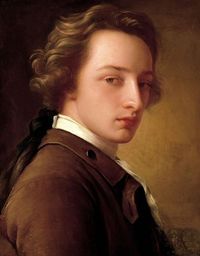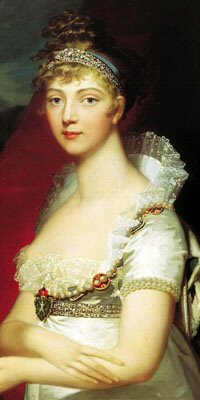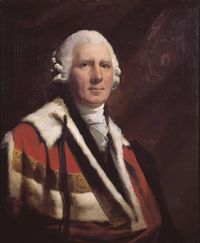How the British Aristocracy Works: Difference between revisions
mNo edit summary |
m (→Dowagers) |
||
| Line 198: | Line 198: | ||
==Dowagers== | ==Dowagers== | ||
On the marriage of a peer or Baronet, the widow of the previous holder of the title becomes Dowager and is addressed as the Right Hon. the Dowager Countess of ... / The Dowager Lady ... As more than one Dowager may hold the same title, the Christian name is used as a distinction - e.g. The Right Hon. [[Sophronia Grenfell|Sophronia]], [[Barony | On the marriage of a peer or Baronet, the widow of the previous holder of the title becomes Dowager and is addressed as the Right Hon. the Dowager Countess of ... / The Dowager Lady ... As more than one Dowager may hold the same title, the Christian name is used as a distinction - e.g. The Right Hon. [[Sophronia Grenfell|Sophronia]], [[Barony de Grave|Baroness de Grave]]. | ||
==The courtesy title 'Honourable'== | ==The courtesy title 'Honourable'== | ||
Revision as of 02:35, 24 May 2017
A man taking the cloth or taking silk would be expected to go to University, usually either Oxford or Cambridge in this period - Durham, the third oldest of the English universities, was not established until 1832. The Scottish universities were considered second-class (at best), despite Scotland having more universities earlier. Scotland was also the centre for medical studies.
Generally speaking, a boy entered the Navy at a young age - 11 0r 12 was common - and would be listed on the ship's books as Captain's servant or (more usually by 1809) Volunteer First Class. This was in contrast to boys entering the Navy with no expectation of progressing further than petty officer, who would be listed as Boys Third Class, if they were below the age of 16 or Boys Second Class if they were between 16 and 18.
Once a Volunteer First Class had reached the age of 19, he was eligible to be rated Midshipman. Once he had reached the age of 21, he could sit his Examination for Lieutenant. If he passed this, he was eligible for a commission as Lieutenant to a named ship. If he did not receive a commission, he remained aboard his ship as a 'passed midshipman', awaiting a vacancy.
A boy could join the Army straight from school: it is not unusual to hear of fourteen-year-old Ensigns commanding men twice their age or more. Commissions could be purchased for a specific sum, and it was possible to purchase promotion all the way up to Lieutenant Colonel, although one had to spend a specific amount of time in a rank before he could purchase the next rank up the ladder. Officers very often changed regiments in order to move up the ranks. Note: There is no requirement to continue schooling to the age of sixteen or eighteen; boys could leave school to enter the adult world of employment at almost any age, and there were only certain professions that required a university degree.
Back to the aristocracy. The British Peerage has levels. Going down the scale these are:
- Duke and Duchess
- Marquess and Marchioness
- Earl and Countess
- Viscount and Viscountess
- Baron and Baroness
The below may look, at first glance, to be complicated, but it is not necessarily so. Address: how to address a letter - what's written on the outside of the cover (envelopes weren't invented until later in the nineteenth century). Begin: how to begin the letter. Refer to: how to refer to them to a third party, or in the third person. When speaking to a peer directly, Dukes and Duchesses are 'Your Grace' all others are 'My Lord (or Lady)' or (very formally) 'Your Lordship (or Ladyship). Courtesy titles are just that: in actual practise, holders of courtesy titles are commoners (which is why you can end up with oddities such as Lord North being Prime Minister earlier in the eighteenth century).
A note: I've borrowed actual LL titles and names for my examples, just to help make it clearer. See also the article Titles: The Definitive and Easy Version.
The Peerage
Dukes, Duchesses and their Children

Duke
Address: His Grace the Duke of Pennington
Begin: My Lord Duke
Refer to as: Your Grace
Duchess
Address: Her Grace the Duchess of Leicester
Begin: Madam
Refer to as: Your Grace
Duke's Eldest Son and his Children
A duke's eldest son takes his father's second title as a courtesy title, and this is treated as if it were an actual peerage. His eldest son takes the grandfather's third title (if any), and is addressed as if he were a peer.
Duke's eldest son's wife:
Address as if her husband's title is an actual peerage.
Duke's Younger Son:
Address: Lord (Christian name and surname) (Lord William Gosling)
Begin: My Lord
Refer to as: Your Lordship
Duke's Younger Son's Wife
Address: Lady (husband's Christian name and surname) (Lady Edmund Harpole - yes, it looks weird.)
Begin: My Lady
Refer to as: Your Ladyship
Duke's Daughter
Address: The Lady (Christian name and surname). The surname is her husband's if she is married. (Lady Elizabeth Dunford)
Begin: Madam
Refer to as: Your Ladyship
If she is married to a peer, she is addressed according to her husband's rank and title, unless he is a peer by courtesy and uses his father's second title.
Marquesses and Marchionesses

Marquess
Address: The Most Hon. the Marquess of Emerson
Begin: My Lord Marquess
Refer to as: Your Lordship
Marquess' Sons: Address as for Duke's sons (Eldest borrows his father's second title, subsequent are Lord Firstname Secondname)
Marquess' Daughter: Address as for Duke's daughter
Marchioness
Address: The Most Hon. the Marchioness of Eastborough
Begin: Madam
Refer to as: Your Ladyship
Earls and Countesses
Earl
Address: The Right Hon. the Earl of Rotherham
Begin: My Lord
Refer to as: Your Lordship
Earl's daughter: Address as for Duke's daughter (Lady Viola Fitzgerald)
Earl's Eldest Son and Son's Wife: Address as if the courtesy title is an actual peerage
Earl's Younger Son and Son's Wife: Address as for Baron's son and his wife (The Honourable Robert Fitzgerald)
Countess:
Address: The Right Hon. the Countess of Carrington
Begin: Madam
Refer to as: Your Ladyship
Viscounts and Viscountesses

Viscount
Address: The Right Hon. the Viscount Hawkesly
Begin: My Lord
Refer to as: Your Lordship
Viscountess
Address: The Right Hon. the Viscountess Saltash
Begin: Madam
Refer to as: Your Ladyship
Viscount's Daughter, Son and Son's Wife: Address as for Baron's daughter, son and son's wife. (Mr the Honourable Robert Vickery, Miss the Honourable Blanche Carey)
Barons and Baronessess
Baron
Address: The Right Hon. the Lord Wrotham or The Lord Braylock
Begin: My Lord
Refer to as: Your Lordship
Baroness (wife of a Baron)
Address: the Right Hon. Lady Louth
Begin: Madam
Refer to as: Your Ladyship
Baron's Son
Address: The Hon. (Christian name and surname)
Begin: Sir. (Eldest sons of Barons in the Peerage of Scotland are usually addressed The Hon. the Master of [peerage title].)
Baron's Son's Wife
Address: The Hon. Mrs. [husband's surname] or, if necessary for distinction (if two sons are married) the husband's Christian name should also be used.
Begin: Madam
- Note: If she is the daughter of a Duke, Earl or Marquess, she should be addressed as such; that is the more senior rank
Baron's Daughter
Address: The Hon. (Christian name and surname); if married to a commoner The Hon. Mrs. [husband's surname]. If married to a Baron or Knight, The Hon. Lady [husband's surname]
Begin: Madam
- Note: If she is the wife of a peer, or of the son of a Duke or Marquess, address as such - that rank takes precedence
Baronets and Knights
Baronet:
Address: Sir [Christian name and surname], Bart. (Sir Philip Vaudrey, Bt)
Begin: Sir
'Baronet's Wife
Address: Lady [surname] (Lady Vaudrey)
Begin: Madam
Refer to as: Your Ladyship
Knight Bachelor
Address as Baronet, except that the word 'Bart' or contraction 'Bt' is omitted.
Dowagers
On the marriage of a peer or Baronet, the widow of the previous holder of the title becomes Dowager and is addressed as the Right Hon. the Dowager Countess of ... / The Dowager Lady ... As more than one Dowager may hold the same title, the Christian name is used as a distinction - e.g. The Right Hon. Sophronia, Baroness de Grave.
The courtesy title 'Honourable'
All sons and daughters of a Baron or Viscount are styled 'The Honourable' - as the Honourable Emma Vickery or Captain the Honourable John Vickery. However, this title is only used in writing (on calling cards or when addressing a letter) and is never used when being introduced.
The elder son of an Earl takes his father's second title if there is one) and all the Earl's daughters are Lady Firstname - Lady Olivia Fitzgerald is the daughter of the Earl of Rotherham and her eldest brother is Richard, Viscount Surrey by courtesy. His younger brother would be the Honourable Robert Fitzgerald.
(As explained above, younger sons of peers ranked higher than an Earl are Lord Firstname Surname, so Lord Gabriel Pritchard is the younger son of the Marquess of Emerson.)
On Introductions
A person would never introduce themselves to someone else (Mr Collins' faux pas in Pride and Prejudice, which Elizabeth Bennet tries to prevent.) One would always be introduced by a mutual acquaintance - in the Assembly Rooms in Bath where Mrs Allen and Mr Tilney have no mutual acquaintance, Mr Tilney has the Master of Ceremonies perform the introductions, which was part of the MC's job description).
The lower-ranked person is introduced to the higher-ranked one... but only if the higher-ranked person requests it, or grants permission. (Towards the end of Pride and Prejudice, Lady Catherine de Bourgh does not grant Elizabeth permission, at first, to introduce Mrs Bennet to her, forcing an uncomfortable silence - people cannot talk without being introduced.)
A proper introduction goes something along the lines of, "Lady [Julianne Grafton|Julianne]], please allow me to introduce my daughter/cousin/friend Miss Smith. Miss Smith, Lady Julianne Grafton." It is explained to the senior (Lady Julianne here) how the introducer knows the other (Miss Smith) but it is not explained to Miss Smith how the introducer knows Lady Jane - the inference being that that can be explained afterwards.
The eldest daughter is Miss Jones, her sisters are Miss Maria Jones and Miss Emily Jones. If Miss Maria is visiting relations in another part of the country, she becomes Miss Jones by courtesy. When the eldest sister marries, Miss Maria becomes Miss Jones in fact.
The same rule applies for men - the eldest son is Mister Grey, his brothers are Mister James Grey (of marriageable age) and Master Edward (still at school). The courtesy title 'The Honourable' is never used in person, only in writing (on cards and when addressing letters).